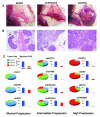Differentially expressed genes regulating the progression of ductal carcinoma in situ to invasive breast cancer
- PMID: 22751464
- PMCID: PMC3899801
- DOI: 10.1158/0008-5472.CAN-12-0636
Differentially expressed genes regulating the progression of ductal carcinoma in situ to invasive breast cancer
Abstract
Molecular mechanisms mediating the progression of ductal carcinoma in situ (DCIS) to invasive breast cancer remain largely unknown. We used gene expression profiling of human DCIS (n = 53) and invasive breast cancer (n = 51) to discover uniquely expressed genes that may also regulate progression. There were 470 total differentially expressed genes (≥2-fold; P < 0.05). Elevated expression of genes involved in synthesis and organization of extracellular matrix was particularly prominent in the epithelium of invasive breast cancer. The degree of overlap of the genes with nine similar studies in the literature was determined to help prioritize their potential importance, resulting in 74 showing overlap in ≥2 studies (average 3.6 studies/gene; range 2-8 studies). Using hierarchical clustering, the 74-gene profile correctly categorized 96% of samples in this study and 94% of samples from 3 similar independent studies. To study the progression of DCIS to invasive breast cancer in vivo, we introduced human DCIS cell lines engineered to express specific genes into a "mammary intraductal DCIS" xenograft model. Progression of xenografts to invasive breast cancer was dramatically increased by suppressing four genes that were usually elevated in clinical samples of DCIS, including a protease inhibitor (CSTA) and genes involved in cell adhesion and signaling (FAT1, DST, and TMEM45A), strongly suggesting that they normally function to suppress progression. In summary, we have identified unique gene expression profiles of human DCIS and invasive breast cancer, which include novel genes regulating tumor progression. Targeting some of these genes may improve the detection, diagnosis, and therapy of DCIS.
©2012 AACR.
Figures





Similar articles
-
Evidence that molecular changes in cells occur before morphological alterations during the progression of breast ductal carcinoma.Breast Cancer Res. 2008;10(5):R87. doi: 10.1186/bcr2157. Epub 2008 Oct 17. Breast Cancer Res. 2008. PMID: 18928525 Free PMC article.
-
Profiling differential microRNA expression between in situ, infiltrative and lympho-vascular space invasive breast cancer: a pilot study.Clin Exp Metastasis. 2018 Feb;35(1-2):3-13. doi: 10.1007/s10585-017-9868-4. Epub 2017 Dec 6. Clin Exp Metastasis. 2018. PMID: 29214365
-
Gene expression profiling of tumour epithelial and stromal compartments during breast cancer progression.Breast Cancer Res Treat. 2012 Aug;135(1):153-65. doi: 10.1007/s10549-012-2123-4. Epub 2012 Jun 21. Breast Cancer Res Treat. 2012. PMID: 22718308
-
Field cancerization in mammary carcinogenesis - Implications for prevention and treatment of breast cancer.Exp Mol Pathol. 2012 Dec;93(3):391-8. doi: 10.1016/j.yexmp.2012.10.018. Epub 2012 Nov 6. Exp Mol Pathol. 2012. PMID: 23142414 Review.
-
Progression from ductal carcinoma in situ to invasive breast cancer: revisited.Mol Oncol. 2013 Oct;7(5):859-69. doi: 10.1016/j.molonc.2013.07.005. Epub 2013 Jul 12. Mol Oncol. 2013. PMID: 23890733 Free PMC article. Review.
Cited by
-
Enhancing spatial domain detection in spatial transcriptomics with EnSDD.Commun Biol. 2024 Oct 21;7(1):1358. doi: 10.1038/s42003-024-07001-y. Commun Biol. 2024. PMID: 39433947 Free PMC article.
-
Systematic identification and characterization of novel human skin-associated genes encoding membrane and secreted proteins.PLoS One. 2013 Jun 20;8(6):e63949. doi: 10.1371/journal.pone.0063949. Print 2013. PLoS One. 2013. PMID: 23840300 Free PMC article.
-
Murine microenvironment metaprofiles associate with human cancer etiology and intrinsic subtypes.Clin Cancer Res. 2013 Mar 15;19(6):1353-62. doi: 10.1158/1078-0432.CCR-12-3554. Epub 2013 Jan 21. Clin Cancer Res. 2013. PMID: 23339125 Free PMC article.
-
FGFR1 amplification and the progression of non-invasive to invasive breast cancer.Breast Cancer Res. 2012 Nov 14;14(6):116. doi: 10.1186/bcr3340. Breast Cancer Res. 2012. PMID: 23151501 Free PMC article.
-
Metastasis-suppressor NME1 controls the invasive switch of breast cancer by regulating MT1-MMP surface clearance.Oncogene. 2021 Jun;40(23):4019-4032. doi: 10.1038/s41388-021-01826-1. Epub 2021 May 19. Oncogene. 2021. PMID: 34012098 Free PMC article.
References
-
- Allred DC. Biological features of human premalignant breast disease and the progression to cancer. In: Harris JR, Lippman ME, Mlorrow M, Hellman S, Osborne CK, editors. Diseases of the Breast. 4th ed Lippincott Williams and Wilkins; Philadelphia: 2009. pp. 323–34.
-
- Allred DC, Wu Y, Mao S, et al. Ductal carcinoma in situ and the emergence of diversity during breast cancer evolution. Clin Cancer Res. 2008;14:370–8. - PubMed
-
- Society AC. Breast Cancer Facts and Figures 2011-2012. 2010.
-
- Kuerer HM, Albarracin CT, Yang WT, et al. Ductal carcinoma in situ: state of the science and roadmap to advance the field. J Clin Oncol. 2009;27:279–88. - PubMed
-
- Page DL, Dupont WD, Rogers LW, Jensen RA, Schuyler PA. Continued local recurrence of carcinoma 15-25 years after a diagnosis of low grade ductal carcinoma in situ of the breast treated only by biopsy. Cancer. 1995;76:1197–200. - PubMed
Publication types
MeSH terms
Grants and funding
LinkOut - more resources
Full Text Sources
Other Literature Sources
Medical
Molecular Biology Databases
Research Materials

